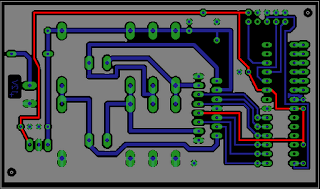1. visualy inspect VCC and GND rails on the PCB
2. use Ohm's law
Visual inspection might be not so easy, have you heard about tin whiskers? http://www.eetimes.com/electronics-news/4234309/Toyota-accelerations-revisited-hanging-by-a--tin--whisker visual inspection is hard and not cool. I decided to use mighty Ohm's law. Presented circuit was designed to by supplied from 5V and all components were already placed so we had to bear in mind that voltage. I set desktop power supply for 5V, current limit for 3A and connected to PCB. Current limit worked and voltage measured across GND and VCC rails was about 0.3V - circuit was shorted.
I marked VCC with red and GND with grey. Short circuit was somwhere between this marked rails. I connected PCB to the power supply like this:
Before I started to measure voltage across PCB tracks I did simple calculation just to know what voltage to expect. I knew that copper on the PCB was 35um thick and that VCC track widht was about 1mm. 1A flowing throug such track should cause voltage drop according to resistance of track. In this case 15mV/cm so values which are easily measured even with cheap chinese multimeter. First I connected multimere like this:
Measured voltage of 0.075V indicated that 3A short circuit current flows through track B. I moved a tip of multimeter further:
Measured voltage increased so I knew that current flowed through part C of track. Repeating that procedure I found drop of tin at the left-most end of track C. That's easy: you are moving one tip of a multimeter and measure voltage across track, if voltage increases - that means that tip of a probe is getting closer to short circuit point. This method is easily extendable and can be used in much more complicated PCBs. I never found it in a handbook so I decided to desribe it and share here. Hope it will help you one day.
Here is real
view of a mentioned PCB:






No comments:
Post a Comment